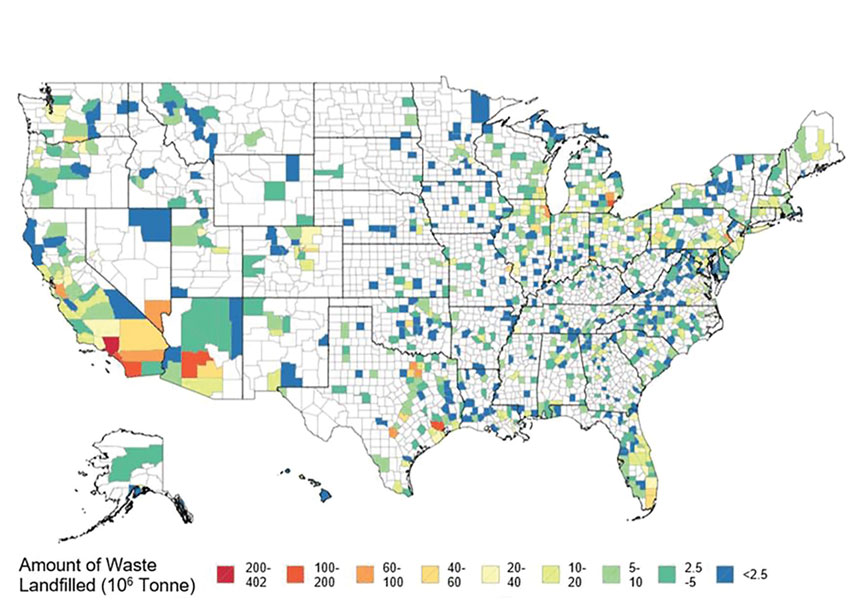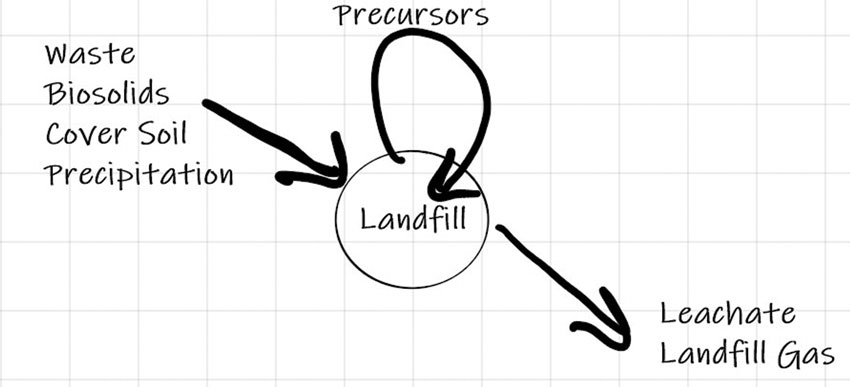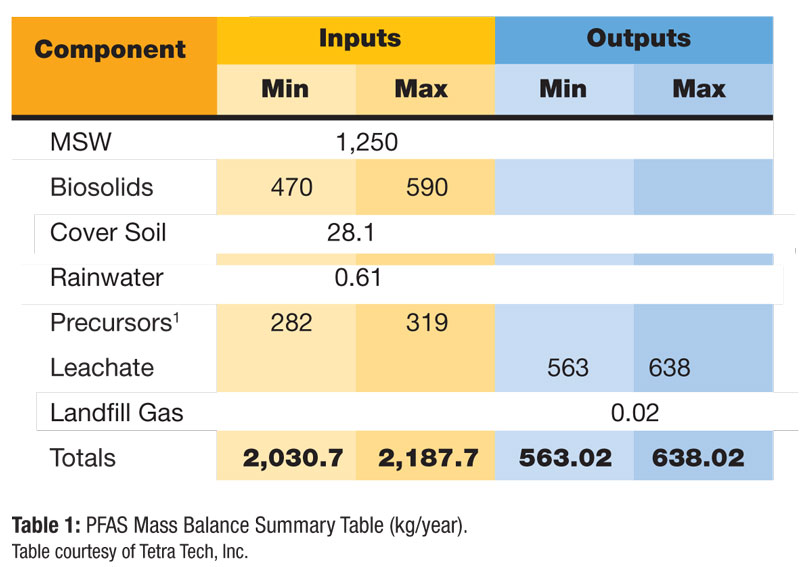Potential for sequestering PFAS shown through mass balance approach.
By Arie Kremen, PhD
Landfill leachate is the major pathway by which per- and polyfluoroalkyl substances (PFAS) exit the containment of modern Subtitle D municipal solid waste landfills. PFAS concentrations in leachate vary over time and can be much greater than those found in sanitary wastewaters. The leachate-borne PFAS contribution to the mass loading of publicly owned treatment works (POTW) that accept leachate can equal that contributed by sanitary and industrial wastewaters. This observation contributes to the perception that landfills are PFAS sources.
However, the wastewater treatment centered perception does not correctly reflect the overall role landfills play in the PFAS cycle. To properly determine this role, we have conducted a mass balance analysis, quantitatively accounting for inputs to and outputs from landfills that convey PFAS. The goal is to determine whether landfills are PFAS sources—as generally perceived—or if they are sequestering PFAS. The high-level analysis is a nationwide mass balance using published research and studies. The results show that the bulk of the landfilled PFAS is sequestered and effectively removed from the environment. The data does have limitations and more work is needed to validate and refine the findings. However, this work serves as a starting point for establishing data-driven PFAS policies and practices. While landfills are shown to sequester PFAS, leachate is the predominant pathway for PFAS out of landfills. Reducing leachate generation is expected to lower the output while reducing operating costs.
PFAS in Landfills Becomes Mobile
PFAS are a group of about 4,000 synthetic chemicals used to make fluoropolymer coatings and products that are resilient to physical, chemical and biological degradation. Products are treated with PFAS to imbue heat, stain, grease and water repellency properties to a wide variety of consumer products, including clothing, furniture, adhesives, food packaging, non-stick cooking surfaces and personal care products. In the environment, PFAS are highly mobile and can bioaccumulate in flora and fauna.
Products at the end of their useful life are discarded in landfills, where mechanical breakdown causes PFAS to detach and become mobile. Mobilized PFAS, together with other constituents, can be carried by landfill liquids and landfill gas (LFG). Modern landfills are designed and operated to remove liquids and landfill gas to ensure stability, minimize nuisances, and avoid the creation of safety hazards and adverse environmental conditions. Liquids are generally treated to remove contaminants, while landfill gas is either flared, used for energy generation, or converted to renewable natural gas.
PFAS are generally resilient to biological and chemical processes and are typically unaffected by conventional leachate and wastewater treatment. Data shows that PFAS from leachate and sanitary wastewaters accumulate in biosolids generated in biological wastewater treatment. Some jurisdictions allow the land application of biosolids for soil conditioning purposes. Others are restricting land application in favor of other disposal alternatives, including incineration and landfilling. Among other constituents, landfilled biosolids introduce PFAS into the landfill from leachate and other sources.
The mass balance approach evaluates changes over time in the amount of a constituent within a system and can provide insight into the relative strengths of inputs and outputs. When applied to landfills, the main inputs include waste, cover material and precipitation, while the outputs are mostly landfill gas and leachate.
We applied the mass balance approach to evaluate if landfills sequester PFAS. In other words, do landfills retain more PFAS than they release to the environment? The estimate is performed on a national level for municipal solid waste landfills. Figure 1 shows a map of landfilled waste by counties in the U.S.

Map of landfilled waste by counties in the U.S. Credit: Waste Informatics: Establishing Characteristics of Contemporary U.S. Landfill Quantities and Practices, September 2016, Environmental Science & Technology, by Jon Powell, José Carlos Pons, and Marian Ruth Chertow, Yale University.
Mass balance relies on the laws of conservation, one of the most basic tools in scientific investigation. It is routinely applied to a range of static, dynamic, electric, nuclear and chemical systems. Financial budgeting is the application of the law to the world of finance. Mass conservation is generally applied to a well-defined domain (known as the control volume), and accounts for mass entering, leaving or accumulating in the control volume. Mass balance analyses may also consider the production or consumption of a constituent within the control volume in chemical or biological processes. Mass conservation can be expressed as:
M0 + (min – mout + Rnet)Δt = M0+Δt,
where M0 and M0+Δt is the mass contained within the control volume at the start and end of the calculation period, respectively. The terms min and mout are the mass transfer fluxes into and out of the control volume during the investigated time period, and Rnet is the net rate of production and consumption within the domain. If Rnet is positive, mass is generated at a greater pace than it is being consumed. The terms can be quantified using physical, chemical or biological models or data derived from measurements. Figure 2 shows a generalized schematic of the mass balance approach.

Image courtesy of Tetra Tech, Inc.
Inputs to and Outputs from a Typical Landfill
Municipal Solid Waste
PFAS content of municipal solid waste (MSW) varies widely. There is no standard methodology for obtaining representative MSW samples and establishing their PFAS content. Values for individual fractions range from 0 to more than 1,000 nanogram PFAS per gram of sample (ng/g). A value of 10 ng/g is considered a representative figure characterizing the overall MSW PFAS content. According to the EPA, about 52.1 percent (2017) of municipal solid waste is landfilled, representing about 137.7 million tons per year. Based on these figures, the annual PFAS disposal rate is calculated to be 2,755 pounds (lbs) per year (1,250 kilograms (kg)/year).
Biosolids
EPA estimated that biosolid production from wastewater treatment is 7.18 million tons per year (6.51 million kg/year). About 60 percent is land-applied, with 20 percent each being landfilled and incinerated. Landfilling biosolids contributes between 1,030 and 1,295 lbs of PFAS per year (470 to 590 kg/year) (Venkatesan and Halden, 2013).
Cover Soils
Many facilities use offsite materials for daily and intermediate soil cover. Soils used may contain contaminants that make the soils unsuitable for off-landfill applications. Little information is documented on PFAS content in such soils. However, Sepulvado et al. (2011) have evaluated the PFAS content, specifically PFOA and PFOS, in agricultural soils to which biosolids were land-applied. Data from this research is used for a conservative estimate of PFAS input with cover soils. PFAS leached from cover soils is assumed to be accounted for in leachate (see below).
Cover soil use is estimated to be 20 percent of the landfilled waste mass, of which land-applied agricultural soils are assumed to be 1 percent. Based on Sepulvado et al., biosolid land-application can result in PFOS and PFOA concentrations of 200 ng/g and 25 ng/g in agricultural soils, respectively. This results in a total of 225 ng PFAS per gram of soil. From these data, the PFAS input with cover soils is calculated to be 123.9 lbs. per year (56.2 kg/year). Work done by McLachlan et al. (2019) on soil/water partitioning of PFAS found that the majority of leaching occurred within 49 to 120 days, with a partitioning coefficient of approximately 0.5. In other words, PFAS are split 50/50 between soil and water, which means cover soils add about 62.0 lbs. per year to the PFAS mass balance.
Precursors
In addition to the inputs discussed previously, landfilled waste contains precursor compounds that are converted to perfluoroalkyl acids (PFAA). These are considered PFAS. Unfortunately, a lack of analytical standards limits the quantification of PFAA. In the proprietary total oxidizable precursor assay (TOPA), chemical oxidation is applied to a sample converting precursor compounds to terminal PFAA. When applied to landfill leachate, results indicate that precursor compounds can amount to approximately 50 percent.
Precipitation
In the past, rainwater was not considered to be a PFAS transport route. However, research conducted at the National Atmospheric Deposition Program at the University of Wisconsin-Madison detected PFAS in all 37 samples collected. Most samples contain less than 1 ng PFAS per liter (ng/l). The highest concentration was nearly 5.5 ng/l, with a mode concentration of less than 1 ng/l. A separate study by the North Carolina Department of Environmental Quality, Division of Air Quality, found 500 ng/l in samples near a PFAS-producing facility.
Precipitation is the dominant source for leachate generation. For estimation purposes, the annual rainwater infiltration rate equals the leachate generation rate. Lang el al. (2019) provide an estimate of 16,180 million gallons of leachate per year. Conservatively, the rainwater PFAS concentration is assumed to be 10 ng/l. The PFAS input from rainwater is calculated to be 1.35 lbs. per year (0.61 kg/year).
Outputs
Leachate
Lang et al. (2017) developed an estimate for the PFAS mass in leachate, across three climatic regions of the U.S. The model estimates the annual leachate volume and extrapolates PFAS mass from a limited number of samples using a Monte-Carlo analysis. Results indicate that the 90th percentile range for PFAS carried by leachate ranges from 1,240 to 1405 lbs per year (563 to 638 kg/year). The leachate generation rate is estimated to be 16,140 million gallons per year (61.1 million m3/year).
Landfill Gas
Monitoring data indicates that PFAS are dry-deposited in areas downwind of landfills, indicating that fugitive and point-source emissions could be sources. Flaring of landfill gas (LFG) is believed to incompletely destroy PFAS. Tian (2018) directly measured PFAS content in landfill gas and found that concentrations ranged from 650 to 850 pg/m3 of LFG. This mass balance analysis uses a value of 1,000 pg/m3 for a conservative estimate.
Applying the EPA LandGEM model to estimate LFG generation from landfilled MSW with a methane generation rate of k=0.05 1/year and a specific methane generation capacity of L0=100 m3/Mg, the LFG generation in 2020 is estimated to be 771,900 million scfm per year (21,858 m3/year). Based on these estimates, the PFAS content of the annual LFG generation is calculated to be 0.05 lbs. per year (0.02 kg/year). In comparison to the other sources, this amount is negligible. For purposes of this analysis, PFAS contained in fugitive emissions or in flared landfill gas are not considered.
Summing it Up: Most Landfilled PFAS is Sequestered
Table 1 summarizes the PFAS mass loadings of the inputs and outputs considered. Annual PFAS inputs are approximately 2.2 tons, of which MSW contributes about 60 percent. Biosolids and precursors represent 25 percent and 15 percent, respectively. Agricultural cover soils contribute approximately 1 percent. Nationally, the contribution from rainwater is negligible. This is also true for landfills situated in areas with high concentrations in rainwater.
These results show that the majority of the PFAS output is associated with leachate—the amount in landfill gas is negligible. The results also show that less than one third (27.7 percent to 29.2 percent) of PFAS landfilled is collected with leachate. In other words, the bulk of the landfilled PFAS is sequestered and effectively removed from the environment. This amounts to about 3,234 lbs. to 3,415 lbs. per year (1,467 kg to 1,549 kg/year).
More Work Needed to Build on High Level Mass Balance Data
It should be no surprise that landfills retain more PFAS than they are releasing. Modern landfills are designed, constructed, and operated to eliminate uncontrolled discharges and reduce leachate generation. It is also not surprising that leachate is the major pathway for PFAS leaving the landfill environment as they are substantially non-volatile, which means only very low quantities are present in LFG. Landfilled biosolids account for between 83 percent and 93 percent of the PFAS discharged with leachate, indicating that PFAS mass exchange between wastewater treatment and landfill is nearly balanced (see Figure 3).


While this approach can identify overall trends and provide estimates for the average PFAS mass cycle, it does not account for regional variation, nor does is provide site-specific guidance. Two major factors affect the accuracy/usefulness of the evaluation:
• The mass balance is a meta-analysis built upon research conducted by other multi-disciplinary groups. It uses data covering approximately two decades, from the early 2000s to 2019, and there have been delays in data gathering, analysis and publication. Year-over-year changes are likely to be small and their effect on the overall outcome are not expected to change the outcome significantly. Of note is the EPA PFOA Stewardship Program, under which eight major companies agreed to a 95 percent reduction in the manufacture and use of PFOA and its precursors. While the program took effect during the period considered in this research, its effects are offset by the time until such products are landfilled and the import of products from regions that have not joined the program.
• The variety of analytical methods, definitions and decisions by scientists in the PFAS research relied upon in this analysis increases the uncertainty of the data presented. For example, Lang et al. considered 19 substances while Venkatesan and Halden accounted for 13. However, these datasets and others agree that perfluorooctanesulfonic acid (PFOS) and perfluorooctanoic acid (PFOA) account for the majority of the considered PFAS.
The mass balance also relies upon landfilling practice assumptions to estimate certain components. These assumptions are appropriate for this type of high-level analysis, and efforts were made to err on the side of caution.
With these limitations in mind, the mass balance indicates a few areas that will have an impact on future PFAS cycle policies and practices. We may expect that landfilling rates for biosolids will increase, as a reaction of jurisdictions to limit land-application. This is likely to reduce the introduction of PFAS to groundwater sources but increase PFAS disposal at landfills. On a local level, PFAS discharged with leachate to a POTW has been shown to exceed the headworks mass loading from sanitary wastewater in some cases. As effluent from POTW is discharged to streams it can enter the potable water supply. Leachate treatment for PFAS is challenging, due to the nature of leachate and PFAS. Until technological solutions are developed and economically feasible, a larger amount of PFAS can be sequestered by landfilling biosolids. | WA
Arie Kremen, PhD, is a civil and environmental engineer at Tetra Tech, Inc. (Pasadena, CA) with more than 25 years of experience in solid waste engineering and water resources, with a professional specialization on leachate management and disposal. His academic background is in beneficial reuse of reclaimed wastewater, including biological nutrient recovery. He has worked abroad and in the U.S. on wastewater and leachate treatment; landfill design and construction; and landfill remediation/closure projects. Dr. Kremen is the vice-Chair of the SWANA technical committee on landfill liquids, where he is leading the organization’s effort into building a PFAS wiki for the solid waste industry. He can be reached at [email protected].
References
- Lang JR, Allrad BM, Field JA, Levis JW, and Barlaz MA, 2017, National Estimate of Per- and Polyfluoroalkyl Substances (PFAS) Release to US Municipal Landfill Leachate, Environmental Science & Technology, January 20, 2019, Volume 51(4), pp 2197.
- McLachlan MS, Felizeter S, Klein M, Kotthoff M, and De Voogt P, 2019, Fate of a perfluoroalkyl acid mixture in an agricultural soil studied in lysimeters, Chemosphere, May 2019, Volume 223, pp 180.
- Sepulvado JG, Blaine AC, Lakhwinder SH, and Higgins CP, 2011, Occurrence and Fate of Perfluorochemicals in Soil Following the Land Application of Municipal Biosolids, Environmental Science & Technology, March 29, 2011, Volume 45(19), pp 8106.
- Venkatesan AK and Halden RU, 2013, National inventory of perfluoroalkyl substances in archived US biosolids from the 2001 EPA National Sewage Sludge Survey, Journal of Hazardous Materials, May 15, 2013, Volumes 252-253, pp 413.
Note
- Estimated as 50 percent of the leachate PFAS mass loading.
